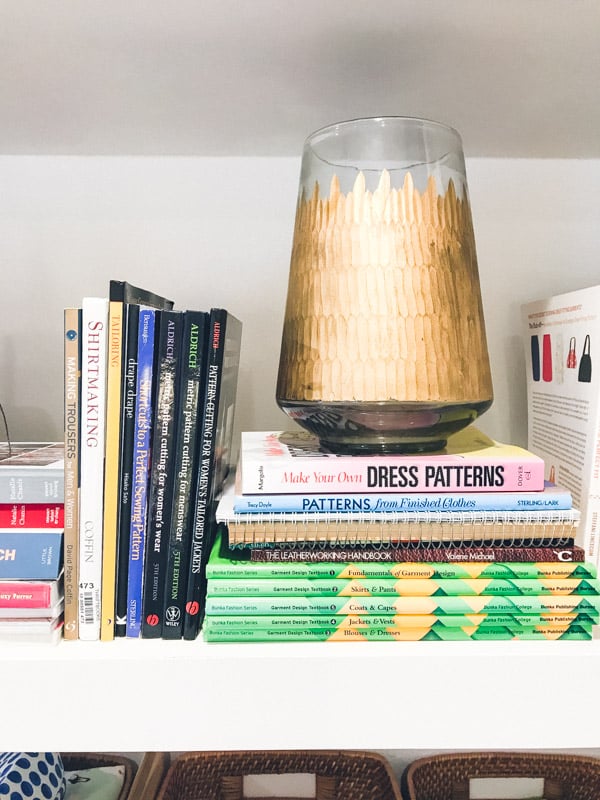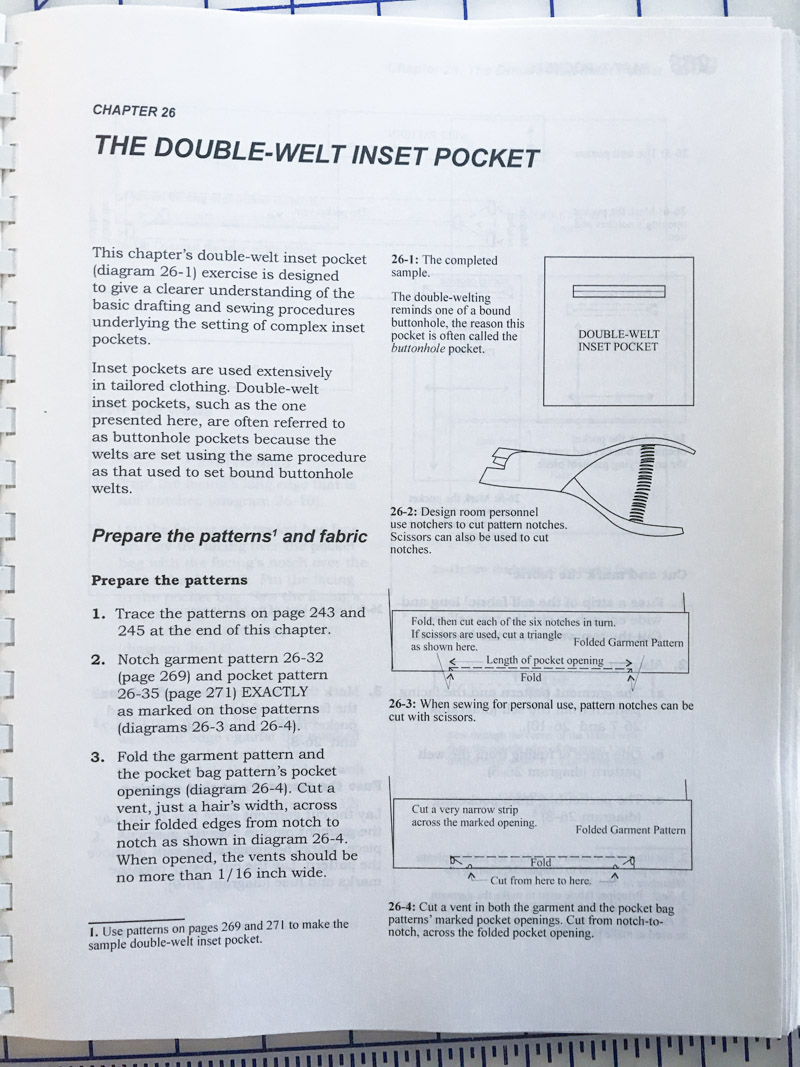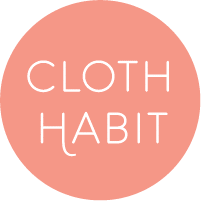
My favorite kind of sewing book is a patternmaking book, and I collect many, even in languages I don’t read. Every patternmaking book has a slightly different way of doing things so I hunt through them to find tidbits I might not see in another book.
One thing I have always wished for in any textbook is more insight into production patternmaking–and what I mean by that is the process of creating patterns according to how they would be sewn in a factory. The seam allowances and markings (if shown at all) are generic in most patternmaking books, and I suspect a large part of that is because these are specifics that are learned on the job, not in a university where most textbooks have their market.
However, I love making home sewing patterns a little more “production pattern” ready, if only because it often makes my sewing so much easier. And this is the kind of subject that deserves its own book.
Enter Design Room Techniques, a hunk of a workbook that fills the nichest niche for those wanting to learn more about production sewing and patterns.

Author: Laurel Hoffmann
Publisher: self-published
Paperback or hardbound: paperback with comb binding
Pages: 455
Additional content: CD insert includes pdfs of the patterns and sample pages (to document samples)
(Note: since I purchased this book it has been updated to include new information and has a new title, Sewing Techniques from the Fashion Industry. The new version can be purchased here. I am reviewing the previous version.)
about the author
Laurel Hoffman is an instructor with experience in home sewing, custom bridalwear design and production patternmaking–all three of which have very different practices. She offers books and private training through her website and business Contemporary Fashion Education.
While there have been other educators that have made a business adapting industry techniques to home sewing, such as Margaret Islander and her niece Janet Pray, Hoffmann’s focus is a bit more technical–a bit more for the patternmakers, which I like!

who is it for
I’m not entirely certain who the main audience for this book is–custom patternmakers, indie designers, production patternmakers, technical patternmaking students? All of the above? But I’m positive anyone in those fields could pick up a thing or two from this book.
If you want to re-engineer a pattern for easier sewing of lapped openings, fly zippers, lined sleeveless dress–all of which tend to have tricky or (ahem) hacky methods in home sewing patterns–this book is your guide. But it’s more than just a collection of “how-tos”; it’s really an instruction manual in how to create procedures.
The point of industrial sewing processes is to make things as clean and steamlined as possible, and that almost always leads to great looking results. For example, here’s the first page of the 6-page explanation for welts with an inset pocket, and as you can see this is a bit different approach than home sewing:

I’ve used a variation of her technique for drafting fly zippers (top photo), and I’m hooked on doing it this way. I’m able to cut, sew and topstitch a fly fast and clean–with no pins, basting or trimming. And it looks mighty fine:

My dislikes?
On the visual side, this book ain’t sexy and while I don’t expect it to be, it could have used a graphic designer. (Yes, even technical books benefit from good technical design.)
And my second complaint is about its binding. I have a thing about crap bindings. So public service announcement time: Plastic comb bindings are better for seminars, not for books that are meant to be opened and used over and over. Nearly any book I have with a comb binding falls apart quickly. (Self publishers: please pretty please, spend the extra money on spiral bindings.)
Regardless of packaging, the information here is gold and anyone with a particular fascination with industrial sewing will get some kicks from trying out a few of these techniques.
Would you like tips and inspiration in the craft of lingerie sewing? Sign up for my weekly eletter The Lingerie Maker.

Thanks so much for this review! I haven’t seen a lot of books that combine pattern making and sewing techniques, when really the two are inseparable. Also, I love that you have the Margolis book in the top photo. I have the 1959 version, which I discovered in my family bookcase when I was in high school in the 80s. It didn’t translate well to the oversized, unisex clothes of the time, but it opened up a whole new world of possibilities to my young mind. I’m pretty sure I was the only girl in my high school who kept a 1/4 scale sloper in my notebook!
How wonderful that you have a vintage copy! I love the Adele Margolis book. It is a treasure of a book and I love her tone of writing–one of my favorites.
Thank you for the review. Although I’m not into pattern drafting (I own enough patterns to make 10 wardrobes for one thing) I’ve been watching Diane Deziel https://www.youtube.com/channel/UCq2hqN9NWIZNJr5vfKxLt8g on youtube and she has some rulers to help with pattern grading that you might find helpful. She’s just a wonder to watch and I’ve learned so much from her in creating my own blocks.
Thanks for the recommendation, Kathleen. I’ll definitely check it out. I do all my drafting and grading on the computer as it is so much faster for me, but it’s still fun to learn from different methods!
How interesting! I just spent weeks deconstructing a RTW skirt that I bought at a sample sale and wore to death. I wanted to recreate it (and take a pattern at the same time for posterity). It had the most unbelievably diabolically complicated concealed-lined-button-zip-combo-fly construction that I have ever seen! While the reconstruction came together in the end, the whole time all I could think was, there’s no way they did it this way in production, it’s just too complicated! Maybe it never made it into production at all because of it! It’s been something of an eye-opener to me to discover how many techniques for the home-sewer are actually more complicated than they need to be. Sleeves are another example! Your book requirements sound exactly like mine, so I’m off to see if I can find me a copy of this 😀
I’ve had this book for years and it is such a gem!! I’m so glad it is getting attention. I used many parts of it here and there but this year I’m on a mission to complete the sample book too!
You might also want to check out the work of Kathleen Fasanella, https://kathleenfasanella.com if you haven’t already. She has a book on production sewing.
Yep, I have it! 🙂
Thank you Amy, for reviewing my book. I wrote Sewing Techniques and the other books in my series because I believe everyone should have access to information about how work is done in the industry’s high-end designing departments.
The book is a composite of the sewing exercises I taught in Philadelphia University-now Jefferson University’s two fashion degree courses: the introductory sewing course, which I developed, and the capstone sewing course, which I wrote. Later I compiled the sewing exercises into Sewing Techniques, which became the sewing course’s textbook for my graduate level six-course Continuing Professional Education program which I taught at Jefferson University, and later Drexel University.
Many of my continuing professional education students wanted to sew more professionally for themselves and their families, some wanted to start businesses or enter the industry. Those who wished to enter industry worked as technical designers at firms such as Federated which makes private label for department stores, and Jones of NY.
The book is comb bound because at present I cannot afford to have my books professionally bound. Hopefully that option is in the near future.
Hi Laurel, thank you for stopping by and for more background information!
Hi Amy,
I’m so glad you like the Curve Runner and I appreciate the shout out!
Claire